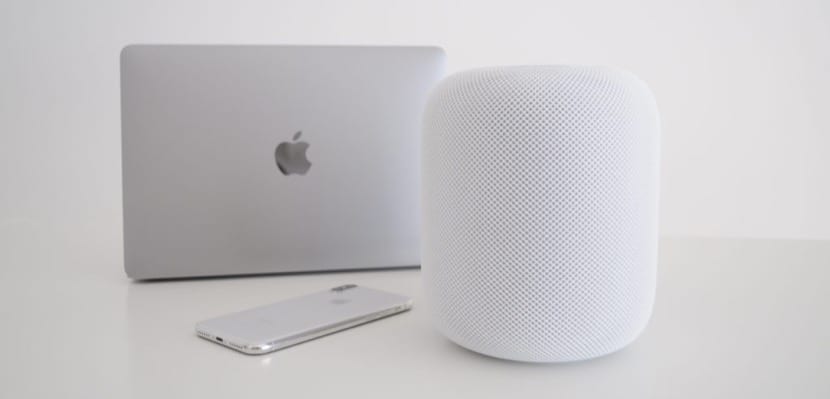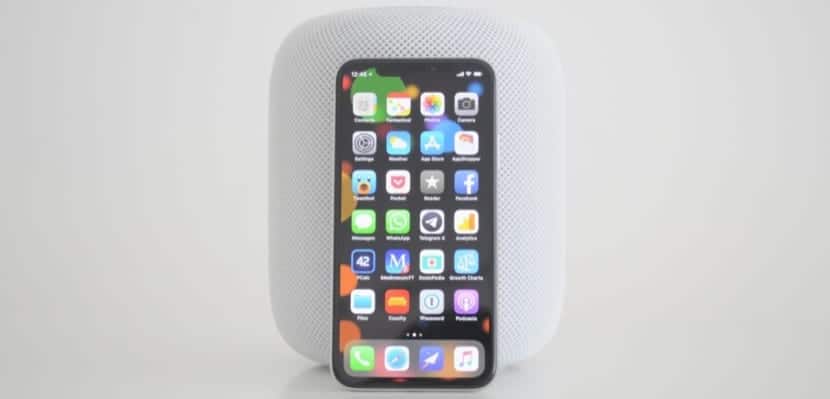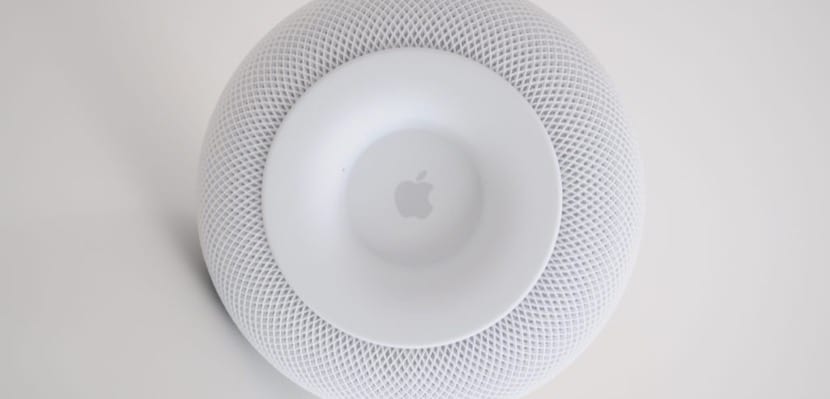
Two weeks ago Apple officially launched the HomePod, although only in the United States, United Kingdom and Australia. A fairly limited release for what the company tends to do lately, and that gives many of us the impression that responds to the company's new strategy of not launching things hastily as far as software is concerned.
Exceptional audio quality for a speaker of its size, but still very nascent software that is also only available in English make this HomePod a device that has great virtues at the moment, but has a wide room for improvement. Behind the initial review that you can see in the video that follows these words, I tell you my impressions after a week using the new Apple smart speaker.
Sound is still fundamental, for now
Smart speakers are still in a very early stage of what they can be. This is how smartphones began, and now phone calls are almost the least important thing a mobile phone offers you, at least for many people. Surely there are days when you do not receive or make any calls, and yet you have been using your smartphone continuously. It may be that in a few years this will be common in smart speakers too, but so far we have not reached this point.
Thus listening to quality music is still essential for a good speaker. And I'm not talking about good music, because everyone has their preferences, but about the music that you like with the best possible sound. The HomePod fulfills that mission with flying colors. With its small size it fills the entire room with good sound, regardless of where you are. Good bass, good mids and good highs ... the sound is distributed by its seven tweeters and its bass speaker with an enormous quality, and the A8 processor that it incorporates handles that sound perfectly.

I would like to check how two linked HomePods work, something that cannot be done at the moment but that will arrive in a software update not too long, maybe with iOS 11.3, probably by the time the HomePod is available in Spain and other countries already the function is implemented. But at the moment with a single speaker I can say that it is more than enough, I would say enough, for a medium-large room. Its maximum volume is harmful to the ears, but does not distort. Even its medium volume is too high if you don't want to disturb the neighbor at nap time.
You get used to voice control early
It has become routine to enter the case and call Siri, and that is currently in English. I don't want to imagine when we can use it in Spanish, but right now even my children already play their music by talking to Siri, they ask the time or about the weather. It is quite a success to have (almost) dispensed with physical controls, among other things because generally one is never near the speaker. You don't usually put the speaker close to where you sit, so why do we want the buttons?
The HomePod allows you to control the volume, pause, start playback, forward and backward by tapping on the top, but once I used them for the review video I have hardly used them again. Talking with Siri is much more effective, and also as it is always listening and always hears you without having to raise your voice, I do not put a single fault to this method. I've been using the AirPods for over a year and haven't gotten used to using Siri with them yet, but with the HomePod it's totally differentIt seems much more natural and you adapt sooner. The current English means that some things you do not understand well, or that there are lists with names in Spanish that you do not recognize, but that will be solved when it is in our language, hopefully sooner rather than later.

I can't stress enough how well Siri listens to you. At first you usually speak in a higher tone than normal, but little by little you realize that it is not necessary, since he hears you better than you might think. Even if there is noise in the room, the television is on or you are even listening to music with the HomePod, Siri always listens to you without having to raise your voice. To such an extent that even the most skeptical person I can use as a "gold standard", nothing more and nothing less than my wife, is already starting to use Siri to turn off the living room lamp when we go to sleep. Before I said that you had to speak very loudly to the iPhone or Apple Watch. Test passed.
Controlling HomeKit with my HomePod
To control your HomeKit-compatible accessories, you used to need an Apple TV or an iPad (much better the first with more control options), but now we can add the HomePod to this list. The Apple speaker becomes a new central for accessories compatible with Apple's home automation platform, and with it comes new ways to control them. Incomprehensibly Apple did not provide the new Apple TV 4K with a microphone that allowed us to give orders to turn off the lights, check the temperature or connect the plug. We were slaves to the iPhone or our Apple Watch, and that made that vocal control not end up being something completely natural.
Apple has managed to take a huge step forward with the HomePod for two reasons. Apple TV is not a very popular product outside of the United States, and although the arrival of Netflix, HBO and Amazon Prime Video have helped to make Apple's device more known and that some already see it interesting, there is still a majority of people who cannot convince themselves that the € 200 Apple TV is worth it. Buy an Apple TV just to control HomeKit? Many see it as something unthinkable already having televisions that integrate the applications they need to watch their series or movies.

However, things may be different with the HomePod. A quality speaker for listening to music with an excellent design and that also allows you to act as a HomeKit central can cause many people to finally decide to buy compatible accessories, and the same can be applied in the other way: many HomeKit users may find the speaker interesting to control your plugs, bulbs and thermostats. That manufacturers like Koogeek or IKEA continue to appear that launch compatible products at more affordable prices will also help.
But a lot of room for improvement
When we talk about the virtues of the HomePod we certainly cannot include its "smart" side. Siri is the virtual assistant that Apple has been developing for years, and if on the iPhone we already complain that it should improve, on the HomePod it is a long way off, almost in diapers. It is true that what it does, it does very well: control Apple Music, send and read messages, queries on the internet such as the weather, the year an album was released or add notes and reminders. But when something works so well, you want more, and here the trouble begins.
There has been much talk of Apple's closed ecosystem in the case of the HomePod, that it is not compatible with Spotify (although it is but not through voice controls) or other third-party applications. For me all this is, for the moment, something expendable. Obviously I am an Apple user and therefore I have an iPhone, iPad, Apple TV and use Apple Music, so the restrictions with third-party services do not affect me too much. But the problem is that Apple has put restrictions even with its own services and applications, and that is incomprehensible.

Messages, Notes and Reminders, in addition to Apple Music, that's all you can use for now if we talk about Apple applications. And something as basic as asking about my calendar events? Although it may seem like a joke, the HomePod can't access your Calendar app, it can't even make a phone call without touching your iPhone. What you can do with your AirPods or with your Apple Watch using Siri you cannot do with the HomePod… Incredible but true. Apple has wanted to make Siri even dumber on its HomePod, and that must be for reasons that we do not know but that must soon be solved.
The possibilities that the HomePod offers you are enormous, and not only within the realm of music. In addition to what it already does (and I repeat, it does it very well) and the obvious it can do (such as calendar events, calls or more advanced consultations on the internet), a world of possibilities opens up that makes you dream. It occurs to me to use and navigate my Apple TV without having to touch the Siri Remote, I start the playback of my favorite series by speaking to my HomePod, and turn it off in the same way. It is just an example of something that could happen shortly, whenever Apple wants, of course.
The HomePod is still in beta
The reality is that the HomePod is still under development. Perhaps the company has been rushed into its hasty launch by the fact that similar products already exist, such as the Google Home or the Amazon Echo, or with Sonos improving its speakers and adding new "smart" functions to its renowned quality in search of capturing part of this new market that appears. A release limited to three countries (UK, US and Australia) and only in Englishwhen Siri already supports many other languages, and with so few features compared to what Siri can do on the iPhone.
All signs point to the HomePod not being finished, like so many other products the company has released. The same was said of the Apple Watch not so long ago, and it goes without saying at what level Apple's smartwatch is now, with virtually no competition in this market. The HomePod will improve, there is no doubt, because it is an opportunity that Apple can not miss. It is always said that it is best to buy the second generation of any new Apple launch, I do not agree. I will love to enjoy the improvements of this first HomePod as they appear, and in the meantime, I enjoy its extraordinary sound.